BIM-Based Life Cycle Assessment of Buildings—An Investigation of Industry Practice and Needs
Abstract
1. Introduction
2. Background
2.1. Data Requirements for LCA of Buildings
2.2. Approaches for Integrating BIM and LCA
2.3. Data Exchange in BIM–LCA
2.4. BIM–LCA at Different Design Stages
2.5. Prototype with Workflow for BIM–LCA
2.5.1. Context
2.5.2. Workflow
2.5.3. Use across Different Design Stages
2.5.4. Open File-Based Data Exchange
2.5.5. Visual Interface
3. Materials and Methods
Qualitative Interviews
- Which digital building model tools (“BIM”) and LCA-tools do you use today?
- How is the BIM–LCA workflow in the company today, and why?
- How do you work with BIM in relation to LCA? E.g., use of discipline models;
- What challenges do you face in BIM–LCA?
- What is most important for a good BIM–LCA workflow? E.g., quick, automation, ease of use, transparency/quality assurance, flexible workflow, precision of data, visual/3D view, evaluation of design solutions, understand LCA and material impacts.
- Does the prototype satisfy these important aspects? What does it meet/doesn’t meet, and why?
4. Results
4.1. BIM–LCA Workflow in Companies
4.2. Data Used for BIM–LCA
4.3. Challenges in BIM–LCA
4.4. User-Perspective on Integration and Response to Prototype
5. Discussion
5.1. Data Management
5.2. Tool for BIM–LCA
5.3. Limitations
6. Conclusions
Author Contributions
Funding
Institutional Review Board Statement
Informed Consent Statement
Data Availability Statement
Acknowledgments
Conflicts of Interest
Glossary
| AEC | Architecture: Engineering and Construction |
| API | Application Programming Interface |
| BIM | Building Information Modeling |
| BoQ | Bill of Quantities |
| DGNB | Deutsche Gesellschaft fur Nachhaltiges Bauen |
| EPD | Environmental Product Declaration |
| FM | Facility Management |
| GHG | Greenhouse Gas |
| HVAC | Heating, Ventilation, and Air Conditioning |
| IFC | Industry Foundation Class |
| JSON | JavaScript Object Notation |
| LCA | Life Cycle Assessment |
| LCI | Life Cycle Inventory |
| LCIA | Life Cycle Impact Assessment |
| LOD | Level of Development |
| MEP | Mechanical, electrical and plumbing |
| VPL | Visual Programming Language |
References
- United Nations Environment Programme. 2020 Global Status Report for Buildings and Construction: Towards a Zero-Emission, Efficient and Resilient Buildings and Construction Sector; United Nations Environment Programme: Nairobi, Kenya, 2020. [Google Scholar]
- Kanafani, K.; Zimmermann, R.K.; Rasmussen, F.N.; Birgisdóttir, H. Learnings from developing a context-specific LCA tool for buildings—The case of lcabyg 4. Sustainability 2021, 13, 1508. [Google Scholar] [CrossRef]
- Frischknecht, R.; Balouktsi, M.; Lützkendorf, T.; Aumann, A.; Birgisdottir, H.; Ruse, E.G.; Hollberg, A.; Kuittinen, M.; Lavagna, M.; Lupišek, A.; et al. Environmental benchmarks for buildings: Needs, challenges and solutions—71st LCA forum, Swiss Federal Institute of Technology, Zürich, 18 June 2019. Int. J. Life Cycle Assess. 2019, 24, 2272–2280. [Google Scholar] [CrossRef]
- Soust-Verdaguer, B.; Llatas, C.; García-Martínez, A. Critical review of bim-based LCA method to buildings. Energy Build. 2017, 136, 110–120. [Google Scholar] [CrossRef]
- Rasmussen, F.N.; Malmqvist, T.; Birgisdóttir, H. Drivers, barriers and development needs for LCA in the Nordic building sector—A survey among professionals. IOP Conf. Ser. Earth Environ. Sci. 2020, 588. [Google Scholar] [CrossRef]
- Balouktsi, M.; Lützkendorf, T.; Röck, M.; Passer, A.; Reisinger, T.; Frischknecht, R. Survey results on acceptance and use of Life Cycle Assessment among designers in world regions: IEA EBC Annex 72. IOP Conf. Ser. Earth Environ. Sci. 2020, 588. [Google Scholar] [CrossRef]
- Obrecht, T.P.; Röck, M.; Hoxha, E.; Passer, A. BIM and LCA Integration: A Systematic Literature Review. Sustainability 2020, 12, 5534. [Google Scholar] [CrossRef]
- Wastiels, L.; Decuypere, R. Identification and comparison of LCA-BIM integration strategies. IOP Conf. Ser. Earth Environ. Sci. 2019, 323. [Google Scholar] [CrossRef]
- Chastas, P.; Theodosiou, T.; Kontoleon, K.J.; Bikas, D. Normalising and assessing carbon emissions in the building sector: A review on the embodied CO2 emissions of residential buildings. Build. Environ. 2018, 130, 212–226. [Google Scholar] [CrossRef]
- Russell-Smith, S.V.; Lepech, M.D.; Fruchter, R.; Littman, A. Impact of progressive sustainable target value assessment on building design decisions. Build. Environ. 2015, 85, 52–60. [Google Scholar] [CrossRef]
- Rasmussen, F.N.; Ganassali, S.; Zimmermann, R.K.; Birgisdóttir, H. LCA benchmarks for residential buildings in Northern Italy and Denmark. Build. Res. Inf. 2019, 47, 833–849. [Google Scholar] [CrossRef]
- Blengini, G.A.; Di Carlo, T. The changing role of life cycle phases, subsystems and materials in the LCA of low energy buildings. Energy Build. 2010, 42, 869–880. [Google Scholar] [CrossRef]
- Röck, M.; Ruschi Mendes Saade, M.; Balouktsi, M.; Nygaard, F.; Birgisdottir, H.; Frischknecht, R.; Habert, G.; Lützkendorf, T. Embodied GHG emissions of buildings—The hidden challenge for e ff ective climate change mitigation. Appl. Energy 2019, 258, 114107. [Google Scholar] [CrossRef]
- Moncaster, A.M.; Rasmussen, F.N.; Malmqvist, T.; Houlihan Wiberg, A.; Birgisdottir, H. Widening understanding of low embodied impact buildings: Results and recommendations from 80 multi-national quantitative and qualitative case studies. J. Clean. Prod. 2019, 235, 378–393. [Google Scholar] [CrossRef]
- International Organization for Standardization. ISO 14040: Environmental Management—Life Cycle Assessment—Principles and Framework; ISO: Geneva, Switzerland, 2006. [Google Scholar]
- International Organization for Standardization. ISO 14044: Environmental Management—Life Cycle Assessment—Requirements and Guidelines; ISO: Geneva, Switzerland, 2006. [Google Scholar]
- European Committee for Standardization. EN 15978: Sustainability of Construction Works—Assessment of Environmental Performance of Buildings—Calculation Method; CEN: Brussels, Belgium, 2011. [Google Scholar]
- Lützkendorf, T. Assessing the environmental performance of buildings: Trends, lessons and tensions. Build. Res. Inf. 2017, 3218, 1–21. [Google Scholar] [CrossRef]
- Zimmermann, R.K.; Skjelmose, O.; Jensen, K.G.; Jensen, K.K.; Birgisdottir, H. Categorizing Building Certification Systems According to the Definition of Sustainable Building. IOP Conf. Ser. Mater. Sci. Eng. 2019, 471. [Google Scholar] [CrossRef]
- The government (the Social Democratic Party); Venstre; Dansk Folkeparti; the Socialist People’s Party; Radikale Venstre; Enhedslisten; the Conservative People’s Party and the Alternative. National Strategi for Bæredygtigt Byggeri; The Danish parliament: Copenhagen, Denmark, 2021; pp. 1–8. [Google Scholar]
- Meex, E.; Hollberg, A.; Knapen, E.; Hildebrand, L.; Verbeeck, G. Requirements for applying LCA-based environmental impact assessment tools in the early stages of building design. Build. Environ. 2018, 133, 228–236. [Google Scholar] [CrossRef]
- Lamé, G.; Leroy, Y.; Yannou, B. Ecodesign tools in the construction sector: Analyzing usage inadequacies with designers’ needs. J. Clean. Prod. 2017, 148, 60–72. [Google Scholar] [CrossRef]
- Saunders, C.L.; Landis, A.E.; Mecca, L.P.; Jones, A.K.; Schaefer, L.A.; Bilec, M.M. Analyzing the practice of life cycle assessment: Focus on the building sector Saunders et al. Analyzing the practice of life cycle assessment. J. Ind. Ecol. 2013, 17, 777–788. [Google Scholar] [CrossRef]
- Marsh, R.; Rasmussen, F.N.; Birgisdottir, H. Embodied Carbon Tools for Architects and Clients Early in the Design Process; Pomponi, F.A., Moncaster, C.D.W., Eds.; Springer: Berlin/Heidelberg, Germany, 2018; ISBN 978-3-319-72796-7. [Google Scholar]
- Basbagill, J.; Flager, F.; Lepech, M.; Fischer, M. Application of life-cycle assessment to early stage building design for reduced embodied environmental impacts. Build. Environ. 2013, 60, 81–92. [Google Scholar] [CrossRef]
- John, V. Derivation of Reliable Simplification Strategies for the Comparative LCA of Individual and “Typical” Newly Built Swiss Apartment Buildings. Ph.D. Thesis, ETH, Zürich, Switzerland, 2012. [Google Scholar]
- The European Parliament and the Council of the European Union. Directive 2014/24/EU of The European Parliament and of The Council of 26 February 2014 on Public Procurement and Repealing Directive 2004/18/EC (Text with EEA Relevance). Off. J. Eur. Union 2014, 94, 65–242. [Google Scholar]
- Erhvervsministeriet. Udbudsloven; Erhvervsministeriet: Copenhagen, Denmark, 2015; pp. 1–9. [Google Scholar]
- Transport- og Boligministeriet. Bekendtgørelse om Anvendelse af Informations- og Kommunikationsteknologi (IKT) i Offentligt Byggeri; Transport- og Boligministeriet: Copenhagen, Denmark, 2013. [Google Scholar]
- Laakso, M.; Kiviniemi, A. The IFC standard—A review of history, development, and standardization. Electron. J. Inf. Technol. Constr. 2012, 17, 134–161. [Google Scholar]
- Theißen, S.; Höper, J.; Drzymalla, J.; Wimmer, R.; Markova, S.; Meins-Becker, A.; Lambertz, M. Using Open BIM and IFC to Enable a Comprehensive Consideration of Building Services within a Whole-Building LCA. Sustainability 2020, 12, 5644. [Google Scholar] [CrossRef]
- Horn, R.; Ebertshäuser, S.; Di Bari, R.; Jorgji, O.; Traunspurger, R.; von Both, P. The BIM2LCA approach: An industry foundation classes (IFC)-based interface to integrate life cycle assessment in integral planning. Sustainability 2020, 12, 6558. [Google Scholar] [CrossRef]
- Santos, R.; Costa, A.A.; Silvestre, J.D.; Pyl, L. Integration of LCA and LCC analysis within a BIM-based environment. Autom. Constr. 2019, 103, 127–149. [Google Scholar] [CrossRef]
- Figl, H.; Ilg, M.; Battisti, K. 6D BIM-Terminal: Missing Link for the design of CO-neutral buildings. IOP Conf. Ser. Earth Environ. Sci. 2019, 323. [Google Scholar] [CrossRef]
- Saridaki, M.; Psarra, M.; Haugbølle, K. Implementing life-cycle costing: Data integration between design models and cost calculations. J. Inf. Technol. Constr. 2019, 24, 14–32. [Google Scholar]
- Kiss, B.; Röck, M.; Passer, A.; Szalay, Z. A cross-platform modular framework for building Life Cycle Assessment. IOP Conf. Ser. Earth Environ. Sci. 2019, 323. [Google Scholar] [CrossRef]
- Röck, M.; Hollberg, A.; Habert, G.; Passer, A. LCA and BIM: Visualization of environmental potentials in building construction at early design stages. Build. Environ. 2018, 140, 153–161. [Google Scholar] [CrossRef]
- Tsikos, M.; Negendahl, K. Sustainable Design with Respect to LCA Using Parametric Design and BIM Tools. In Proceedings of the World Sustainable Built Environment Conference 2017, Wan Chai, Hong Kong, 5–7 June 2017. [Google Scholar]
- CSTB EveBIM. Available online: https://www.evebim.fr/ (accessed on 23 April 2021).
- Cavalliere, C.; Dell’Osso, G.R.; Pierucci, A.; Iannone, F. Life cycle assessment data structure for building information modelling. J. Clean. Prod. 2018, 199, 193–204. [Google Scholar] [CrossRef]
- Mora, T.D.; Bolzonello, E.; Cavalliere, C.; Peron, F. Key parameters featuring bim-lca integration in buildings: A practical review of the current trends. Sustainability 2020, 12, 7182. [Google Scholar] [CrossRef]
- Antón, L.Á.; Díaz, J. Integration of life cycle assessment in a BIM environment. Procedia Eng. 2014, 85, 26–32. [Google Scholar] [CrossRef]
- Díaz, J.; Antön, L.Á. Sustainable construction approach through integration of LCA and BIM tools. In Proceedings of the 2014 International Conference on Computing in Civil and Building Engineering, Orlando, FL, USA, 23–25 June 2014; pp. 283–290. [Google Scholar] [CrossRef]
- Buildingsmart. Available online: https://www.buildingsmart.org/ (accessed on 11 March 2021).
- Toth, B.; Janssen, P.; Stouffs, R.; Chaszar, A.; Boeykens, S. Custom digital workflows: A new framework for design analysis integration. Int. J. Archit. Comput. 2012, 10, 481–500. [Google Scholar] [CrossRef]
- Negendahl, K. Building performance simulation in the early design stage: An introduction to integrated dynamic models. Autom. Constr. 2015, 54, 39–53. [Google Scholar] [CrossRef]
- Grasshopper. Available online: https://www.grasshopper3d.com/ (accessed on 15 March 2021).
- Dynamo. Available online: https://dynamobim.org/ (accessed on 15 March 2021).
- Cavalliere, C.; Habert, G.; Dell’Osso, G.R.; Hollberg, A. Continuous BIM-based assessment of embodied environmental impacts throughout the design process. J. Clean. Prod. 2019, 211, 941–952. [Google Scholar] [CrossRef]
- Dupuis, M.; April, A.; Lesage, P.; Forgues, D. Method to Enable LCA Analysis through Each Level of Development of a BIM Model. Procedia Eng. 2017, 196, 857–863. [Google Scholar] [CrossRef]
- Durão, V.; Costa, A.A.; Silvestre, J.D.; Mateus, R.; De Brito, J. Integration of environmental life cycle information in BIM objects according with the level of development. IOP Conf. Ser. Earth Environ. Sci. 2019, 225. [Google Scholar] [CrossRef]
- Durão, V.; Costa, A.A.; Silvestre, J.D.; Mateus, R.; Santos, R.; Brito, J. De Current Opportunities and Challenges in the Incorporation of the LCA Method in BIM. Open Constr. Build. Technol. J. 2020, 14, 336–349. [Google Scholar] [CrossRef]
- Frivillig Bæredygtighedsklasse. Available online: https://baeredygtighedsklasse.dk/ (accessed on 16 March 2021).
- Green Building Council Denmark. Available online: https://www.dk-gbc.dk/english/ (accessed on 16 March 2021).
- Ökobaudat. Available online: https://www.oekobaudat.de/ (accessed on 16 March 2021).
- Birgisdottir, H.; Rasmussen, F.N. Development of LCAbyg: A national Life Cycle Assessment tool for buildings in Denmark. IOP Conf. Ser. Earth Environ. Sci. 2019, 290. [Google Scholar] [CrossRef]
- Kanafani, K.; Zimmermann, R.K.; Rasmussen, F.N.; Birgisdóttir, H. Early Design Stage Building LCA Using the LCAbyg Tool: New Strategies for Bridging the Data Gap. IOP Conf. Ser. Earth Environ. Sci. 2019, 323. [Google Scholar] [CrossRef]
- Zimmermann, R.K.; Kanafani, K.; Nygaard Rasmussen, F.; Birgisdóttir, H. Early Design Stage Building LCA using the LCAbyg tool: Comparing Cases for Early Stage and Detailed LCA Approaches. IOP Conf. Ser. Earth Environ. Sci. 2019, 323. [Google Scholar] [CrossRef]
- Theißen, S.; Höper, J.; Wimmer, R.; Zibell, M.; Meins-Becker, A.; Rössig, S.; Goitowski, S.; Lambertz, M. BIM integrated automation of whole building life cycle assessment using German LCA data base ÖKOBAUDAT and Industry Foundation Classes. IOP Conf. Ser. Earth Environ. Sci. 2020, 588. [Google Scholar] [CrossRef]
- Ligurgo, V.; Philippette, T.; Fastrez, P.; Collard, A.S.; Jacques, J. A Method Combining Deductive and Inductive Principles to Define Work-Related Digital Media Literacy Competences. Commun. Comput. Inf. Sci. 2018, 810, 245–254. [Google Scholar] [CrossRef]
- Realdania. Byggeriets Nøgletal; Realdania: Copenhagen, Denmark, 2016. [Google Scholar]
- Danske Arkitektvirksomheder. Available online: https://www.danskeark.dk/content/tal-analyser (accessed on 16 March 2021).
- Röck, M.; Passer, A.; Ramon, D.; Allacker, K. The coupling of BIM and LCA—Challenges identified through case study implementation. In Life Cycle Analysis and Assessment in Civil Engineering: Towards an Integrated Vision; Taylor & Francis Group: London, UK, 2019; pp. 841–846. [Google Scholar]
- Petrova, E.A.; Romanska, I.; Stamenlov, M.; Svidt, K.; Jensen, R.L. Development of an Information Delivery Manual for Early Stage BIM-based Energy Performance Assessment and Code Compliance as a Part of DGNB Pre-certification. In Proceedings of the 15th IBPSA Conference: Building Simulation 2017, San Francisco, CA, USA, 7–9 August 2017. [Google Scholar] [CrossRef]

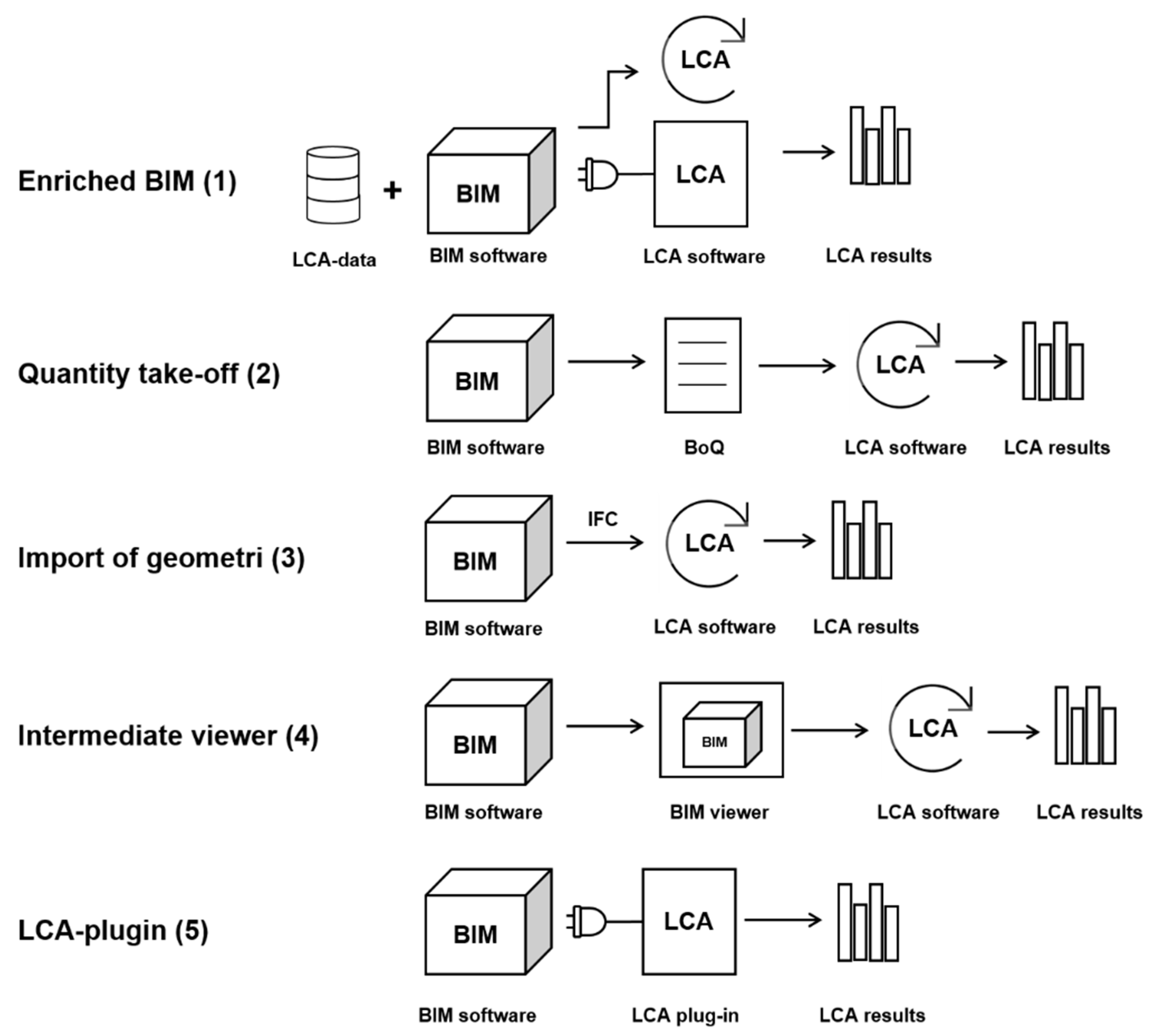
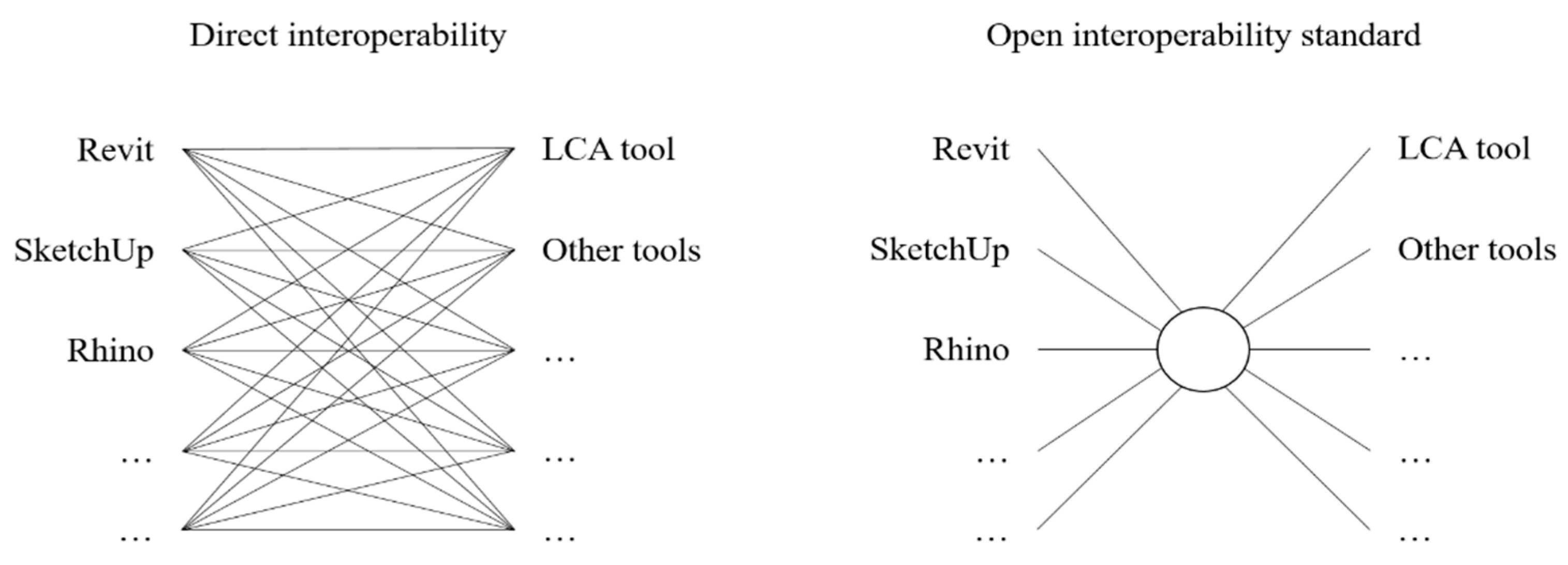
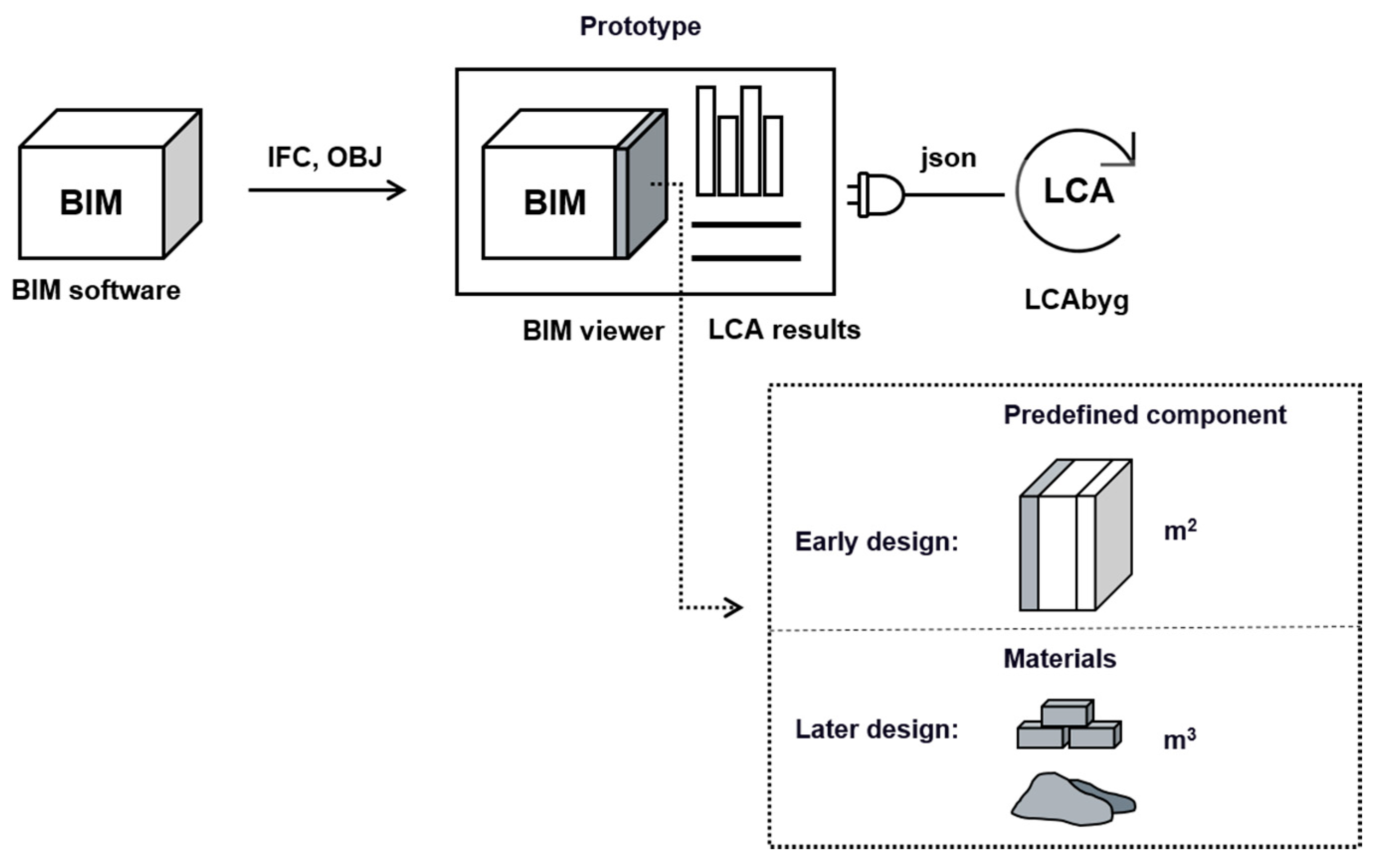
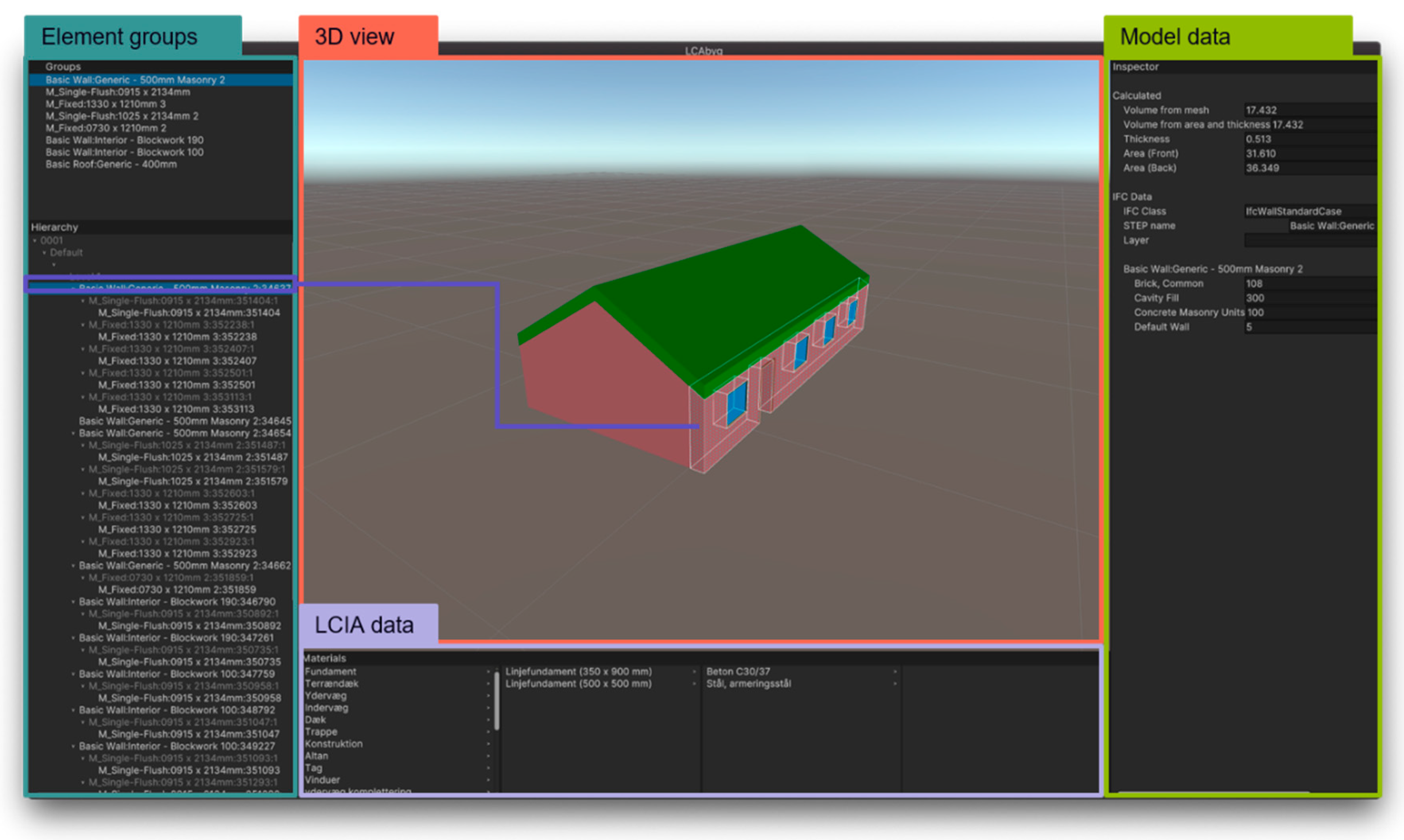

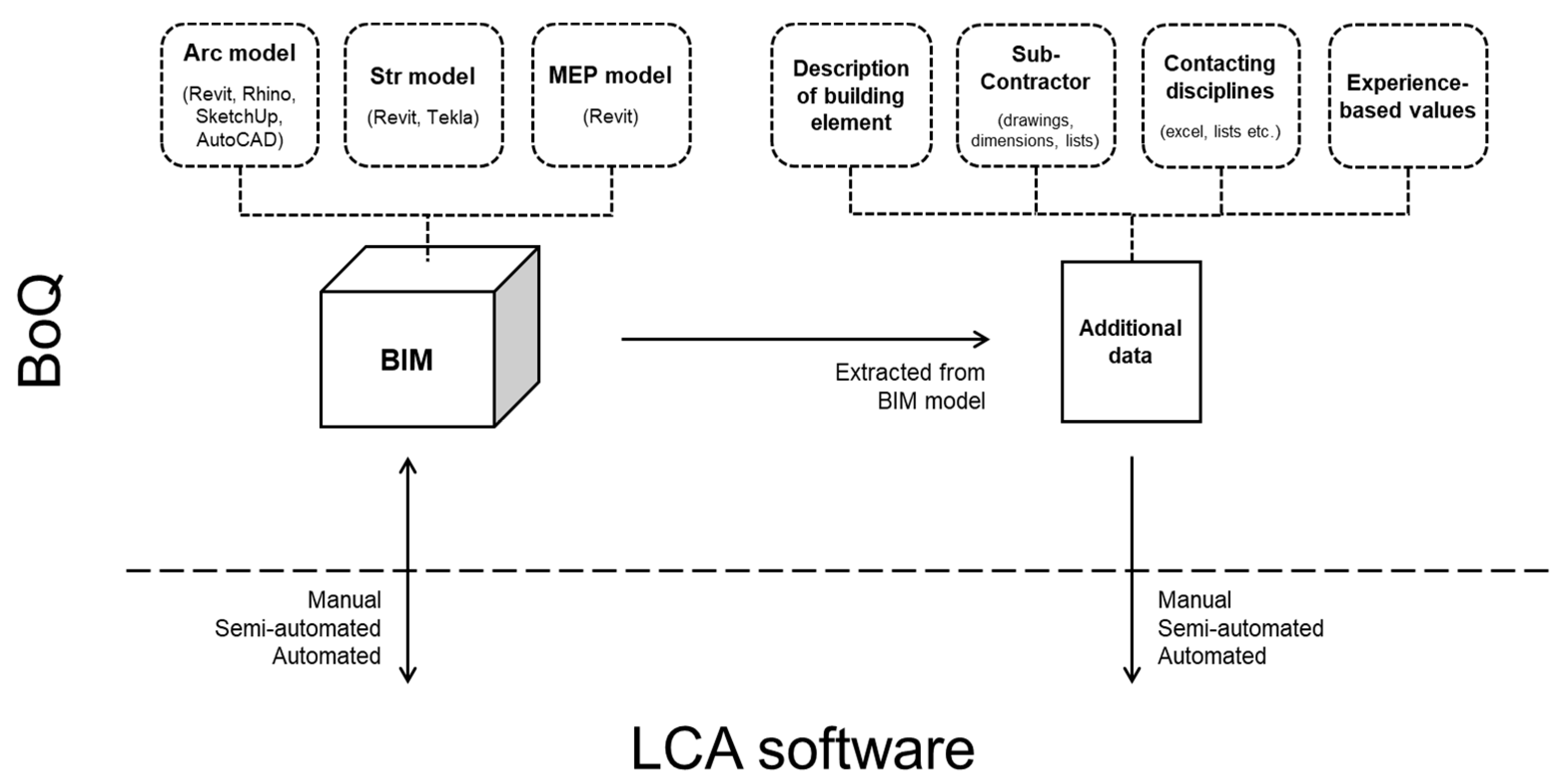
| Model Software | IFC | OBJ |
|---|---|---|
| Revit | x | x |
| Rhinoceros | x 2 | x |
| Sketchup | x 1 | x 1 |
| ArchiCAD | x | x |
| AutoCAD | - | x 2 |
| Vectorworks | x | x |
| Interview | No. of Informants in Interview | Profiles | Company Type | No. of Employees in Denmark (in Ranges) |
|---|---|---|---|---|
| A | 2 | Engineers | Consulting engineers and architects | 3000–3999 |
| B | 2 | Engineer and design engineer | Consulting engineers and architects | 1000–1999 |
| C | 3 | Engineer and design engineer | Consulting engineers | 100–199 |
| D | 1 | Engineer | Consulting engineers | 500–999 |
| E | 2 | Engineer and architect | Consulting architects | 100–199 |
| F | 1 | Architect | Consulting architects | 0–99 |
| G | 2 | Engineer and architect | Consulting engineers and architects | 3000–3999 |
| H | 2 | Engineers | Contractor and consulting engineers | 1000–1999 |
| Challenges | Comments |
|---|---|
| Lack of building-model management for a collaborative process |
|
| Workflow errors |
|
| Lack of data availability and quality in models |
|
| Modeling errors |
|
| Variations in the structure of models |
|
| Data exchange and matching model-data with LCIA data |
|
| Manual workflow and large models |
|
| Important Properties for Integration Process | Comments on Prototype | |
|---|---|---|
| Ease of use (G, H) |
| Cons:
|
| Visual interface (A, B, C, D, E, H) |
| Pros
|
| Evaluation of design solutions (B, C, G, E, H) |
| Pros:
|
| Transparency of data from the building model (A, B, C, H, F) |
| Pros:
|
| Precision and completeness of BoQ data (B, D, E, F) |
| |
| Quick/automation (B, C, D, H, F) |
| Pros:
|
| Flexible workflow in terms of data sources (A, C, E, F, H) |
| Pros:
|
Publisher’s Note: MDPI stays neutral with regard to jurisdictional claims in published maps and institutional affiliations. |
© 2021 by the authors. Licensee MDPI, Basel, Switzerland. This article is an open access article distributed under the terms and conditions of the Creative Commons Attribution (CC BY) license (https://creativecommons.org/licenses/by/4.0/).
Share and Cite
Zimmermann, R.K.; Bruhn, S.; Birgisdóttir, H. BIM-Based Life Cycle Assessment of Buildings—An Investigation of Industry Practice and Needs. Sustainability 2021, 13, 5455. https://doi.org/10.3390/su13105455
Zimmermann RK, Bruhn S, Birgisdóttir H. BIM-Based Life Cycle Assessment of Buildings—An Investigation of Industry Practice and Needs. Sustainability. 2021; 13(10):5455. https://doi.org/10.3390/su13105455
Chicago/Turabian StyleZimmermann, Regitze Kjær, Simone Bruhn, and Harpa Birgisdóttir. 2021. "BIM-Based Life Cycle Assessment of Buildings—An Investigation of Industry Practice and Needs" Sustainability 13, no. 10: 5455. https://doi.org/10.3390/su13105455
APA StyleZimmermann, R. K., Bruhn, S., & Birgisdóttir, H. (2021). BIM-Based Life Cycle Assessment of Buildings—An Investigation of Industry Practice and Needs. Sustainability, 13(10), 5455. https://doi.org/10.3390/su13105455







